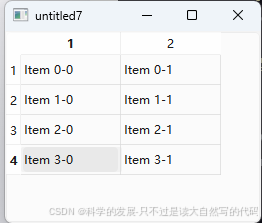QTableView是Qt框架中用于显示和编辑二维表格数据的类。以下是对QTableView的详细解析:
一、基本功能与特点
- 显示二维表格数据:QTableView以网格形式展示数据,每个单元格可以包含文本、图像、复选框等元素。
- 灵活的模型/视图架构:QTableView可以与各种数据模型(如QStandardItemModel)配合使用,实现数据的展示和编辑。
- 丰富的交互功能:支持用户通过点击、双击、键盘操作等方式与表格数据进行交互。
- 高度可定制性:通过自定义委托(如QStyledItemDelegate)和样式表,可以定制表格的外观和行为。
二、主要组件与接口
- QTableView:表格数据的可视化界面,负责展示和编辑数据。
- QStandardItemModel:数据的存储和管理者,负责提供数据给QTableView进行展示。它是一个通用的二维数据存储类,支持任意数据的存储,每个单元格用QStandardItem表示。
- QStyledItemDelegate:连接视图和模型的桥梁,负责绘制和编辑表格单元格的内容。使用当前样式绘制项目,并可以通过重写paint()、createEditor()等函数来自定义单元格的绘制和编辑行为。
三、使用示例
以下是一个使用QTableView、QStandardItemModel和QStyledItemDelegate的示例:
#include <QTableView>
#include <QStandardItemModel>
#include <QStyledItemDelegate>
#include <QLineEdit>
#include <QApplication>
// 自定义委托类,用于绘制和编辑表格单元格的内容
class MyDelegate : public QStyledItemDelegate {
public:
QWidget* createEditor(QWidget* parent, const QStyleOptionViewItem& option, const QModelIndex& index) const override {
// 创建编辑器控件,例如QLineEdit
QLineEdit* editor = new QLineEdit(parent);
return editor;
}
void setEditorData(QWidget* editor, const QModelIndex& index) const override {
// 设置编辑器控件的数据
QString text = index.model()->data(index, Qt::EditRole).toString();
QLineEdit* lineEdit = static_cast<QLineEdit*>(editor);
lineEdit->setText(text);
}
void setModelData(QWidget* editor, QAbstractItemModel* model, const QModelIndex& index) const override {
// 获取编辑器控件的数据并设置到模型中
QLineEdit* lineEdit = static_cast<QLineEdit*>(editor);
QString text = lineEdit->text();
model->setData(index, text, Qt::EditRole);
}
void updateEditorGeometry(QWidget* editor, const QStyleOptionViewItem& option, const QModelIndex& index) const override {
// 更新编辑器控件的几何位置
editor->setGeometry(option.rect);
}
};
int main(int argc, char *argv[]) {
QApplication app(argc, argv);
// 创建QTableView对象
QTableView* tableView = new QTableView;
// 创建QStandardItemModel对象并设置行数和列数
QStandardItemModel* model = new QStandardItemModel(4, 2);
// 为模型设置数据
for (int row = 0; row < 4; ++row) {
for (int column = 0; column < 2; ++column) {
QStandardItem* item = new QStandardItem(QString("Item %1-%2").arg(row).arg(column));
model->setItem(row, column, item);
}
}
// 设置QTableView的数据模型
tableView->setModel(model);
// 创建并设置自定义委托
MyDelegate* delegate = new MyDelegate;
tableView->setItemDelegate(delegate);
// 显示QTableView
tableView->show();
return app.exec();
}
四、注意事项
- 数据模型的选择:QTableView可以与多种数据模型配合使用,选择适合的数据模型可以提高数据处理的效率和灵活性。
- 性能优化:在处理大量数据时,需要注意性能优化,例如通过分页加载数据、使用虚拟滚动等方式减少内存占用和提高响应速度。
- 事件处理:QTableView支持多种事件处理机制,可以根据需要重写相关事件处理函数来实现自定义的行为。
综上所述,QTableView是Qt框架中用于显示和编辑二维表格数据的强大工具,通过与QStandardItemModel和QStyledItemDelegate等组件的配合使用,可以实现高度可定制和灵活的表格数据展示和编辑功能。
QStyledItemDelegate
QStyledItemDelegate是Qt框架中的一个类,用于自定义视图(如QTableView或QTableWidget)中单元格内容的显示和编辑行为。它是QAbstractItemDelegate的子类,提供了默认的显示和编辑行为,但允许开发者通过继承它并重写某些方法来自定义这些行为。以下是关于QStyledItemDelegate的详细解析:
一、基本功能与特点
- 自定义单元格显示:允许开发者为不同的单元格或列设置不同的显示方式,例如使用不同的字体、颜色、对齐方式等。
- 自定义单元格编辑:为单元格提供自定义的编辑器控件,如QLineEdit、QCheckBox等,并控制编辑过程中的数据验证和转换。
- 样式支持:利用Qt的样式表(QSS)和样式引擎来绘制单元格内容,使得自定义的单元格外观与Qt应用程序的整体风格保持一致。
- 高度可定制性:通过重写paint()、createEditor()、setEditorData()、setModelData()和updateEditorGeometry()等方法,可以实现复杂的自定义逻辑。
二、主要方法与用途
-
paint(QPainter *painter, const QStyleOptionViewItem &option, const QModelIndex &index) const:
- 用于绘制单元格的内容。
- painter参数是绘图工具,用于在单元格上绘制文本、图像等。
- option参数包含了绘制选项,如对齐方式、字体、背景色等。
- index参数是单元格的模型索引,用于获取单元格的数据。
-
createEditor(QWidget *parent, const QStyleOptionViewItem &option, const QModelIndex &index) const:
- 用于创建用于编辑单元格内容的编辑器控件。
- parent参数是编辑器的父控件。
- option和index参数与paint方法中的参数相同。
-
setEditorData(QWidget *editor, const QModelIndex &index) const:
- 用于将单元格的数据设置到编辑器控件中。
- editor参数是编辑器控件。
- index参数是单元格的模型索引。
-
setModelData(QWidget *editor, QAbstractItemModel *model, const QModelIndex &index) const:
- 用于将编辑器控件中的数据设置回模型中。
- editor参数是编辑器控件。
- model参数是数据模型。
- index参数是单元格的模型索引。
-
updateEditorGeometry(QWidget *editor, const QStyleOptionViewItem &option, const QModelIndex &index) const:
- 用于调整编辑器控件的大小和位置。
- editor参数是编辑器控件。
- option参数包含了绘制选项,可用于确定编辑器控件的大小和位置。
- index参数是单元格的模型索引。
三、使用示例
以下是一个使用QStyledItemDelegate自定义单元格显示和编辑的示例:
#include <QApplication>
#include <QTableView>
#include <QStandardItemModel>
#include <QStyledItemDelegate>
#include <QLineEdit>
#include <QPainter>
class MyDelegate : public QStyledItemDelegate {
public:
QWidget* createEditor(QWidget* parent, const QStyleOptionViewItem& option, const QModelIndex& index) const override {
// 为特定列创建QLineEdit编辑器
if (index.column() == 1) {
QLineEdit* editor = new QLineEdit(parent);
return editor;
}
return QStyledItemDelegate::createEditor(parent, option, index);
}
void setEditorData(QWidget* editor, const QModelIndex& index) const override {
// 将单元格数据设置到编辑器中
if (QLineEdit* lineEdit = qobject_cast<QLineEdit*>(editor)) {
lineEdit->setText(index.data(Qt::EditRole).toString());
} else {
QStyledItemDelegate::setEditorData(editor, index);
}
}
void setModelData(QWidget* editor, QAbstractItemModel* model, const QModelIndex& index) const override {
// 将编辑器数据设置回模型中
if (QLineEdit* lineEdit = qobject_cast<QLineEdit*>(editor)) {
model->setData(index, lineEdit->text(), Qt::EditRole);
} else {
QStyledItemDelegate::setModelData(editor, model, index);
}
}
void paint(QPainter* painter, const QStyleOptionViewItem& option, const QModelIndex& index) const override {
// 自定义单元格的绘制方式
if (index.column() == 1) {
painter->save();
painter->setBrush(Qt::lightGray);
painter->drawRect(option.rect);
painter->restore();
}
QStyledItemDelegate::paint(painter, option, index);
}
};
int main(int argc, char* argv[]) {
QApplication app(argc, argv);
QTableView tableView;
QStandardItemModel model(4, 2);
model.setHorizontalHeaderLabels({"Name", "Age"});
for (int row = 0; row < 4; ++row) {
model.setItem(row, 0, new QStandardItem(QString("Alice %1").arg(row)));
model.setItem(row, 1, new QStandardItem(QString("30")));
}
tableView.setModel(&model);
MyDelegate* delegate = new MyDelegate;
tableView.setItemDelegateForColumn(1, delegate);
tableView.show();
return app.exec();
}

在这个示例中,我们创建了一个自定义的QStyledItemDelegate子类MyDelegate,并重写了createEditor()、setEditorData()、setModelData()和paint()方法。在paint()方法中,我们为第二列的单元格绘制了一个灰色的背景。在createEditor()方法中,我们为第二列的单元格创建了一个QLineEdit编辑器。这样,当用户编辑第二列的单元格时,就会看到一个文本输入框,并且输入的内容会被设置回模型中。
四、注意事项
- 性能考虑:在重写paint()等方法时,需要注意性能问题。特别是在处理大量数据时,应该尽量减少不必要的重绘和计算。
- 数据验证:在setModelData()方法中,应该添加必要的数据验证逻辑,以确保用户输入的数据是合法和有效的。
- 样式一致性:在自定义单元格的显示方式时,应该尽量保持与Qt应用程序整体风格的一致性,以提高用户体验。
QStyledItemDelegate是Qt框架中用于自定义视图单元格显示和编辑的强大工具,通过灵活使用它,可以实现复杂的自定义逻辑和丰富的用户界面效果。





















 7299
7299

 被折叠的 条评论
为什么被折叠?
被折叠的 条评论
为什么被折叠?








